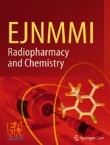Topical Collections about latest and interesting topics in EJNMMI Radiopharmacy and Chemistry are available at: https://link.springer.com/journal/41824/collections
Formulation of a kit under Good Manufacturing Practices (GMP) for preparing [111In]In-BnDTPA-trastuzumab-NLS injection: a theranostic agent for imaging and Meitner-Auger Electron (MAE) radioimmunotherapy of HER2-positive breast cancer
111In[In]-BnDTPA-trastuzumab-NLS is a radiopharmaceutical with theranostic applications for imaging and Meitner-Auger electron (MAE) radioimmunotherapy (RIT) of HER2-positive breast cancer (BC). Nuclear localizat...

